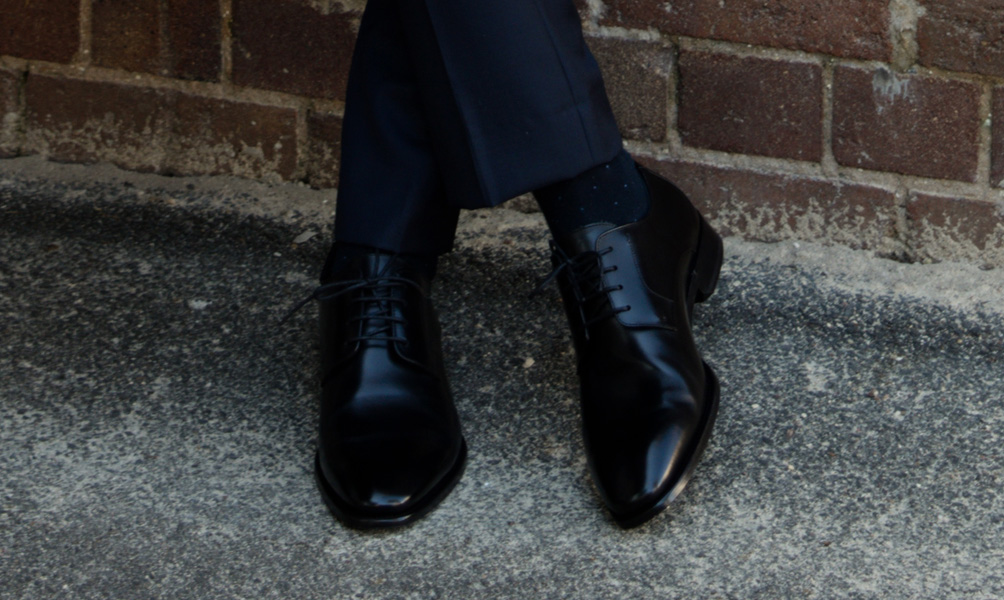02 Feb 2021
Men's Dress Shoes 101: A Beginner's Guide To Dress Shoes
Guys come in two speeds with men’s dress shoes. You either get a kick out of them (so to speak) or you hate the bloody things. And fair enough. If you’re unfamiliar with the whole formal shoe thing, it can be kind of intimidating. All those Oxfords and vamps and ‘brogueing’ etc. Men’s dress shoes belong to the world of gentlemen’s clubs and cigars and plush leather wingbacks, right?
Well, maybe not. Every modern guy needs at least one pair of men’s dress shoes in the wardrobe—if only for weddings and funerals. The trick is picking the right style for your outfit, and looking after them correctly. Here we’re going to break down the most common dress shoe styles, how to wear them, and how to keep them looking like you just walked out of a Rolex commercial.
Men's dress shoe types
There are dozens of men’s dress shoe categories and sub-categories sub-sub-categories and cross-over categories. But we’re not going to dive into the entire glossary here. The style below are the most common you’ll find, and should be suitable for anyone who isn’t an actual prince or something.
Oxfords
Oxfords are the most common type of men’s dress shoe. They can come in ‘Plain Toe’, ‘Wing Tip’, ‘Cap Toe’ and ‘Whole Cut’. The style actually goes back to English college students in the 19th century, especially at Oxford—students wanted something more low-cut and ‘trendy’ than the traditional half-boot Oxbridge shoe. You can recognise Oxfords by their ‘closed lacing’, which means the two sides of the shoe’s facing come together beneath the vamp. This is what gives Oxfords their formal vibe and slim silhouette. They really hug your foot.
How to wear Oxfords
For business attire, look for safe colours like dark brown, tan, black or English tan leather. For black tie tuxedo-wear, always stick to shiny black patent leather. Remember, suede or nubuck Oxfords are going to look more casual. Bonus points for colourful socks under your Oxfords, they’re a great way to add a pop of personality.
Derbys
Derby shoes look almost identical to Oxfords, which is why so many people mix them up. The big difference with Derby shoes is that the lacing is ‘open’, attached above the vamp, giving them a more smart-casual vibe. These shoes are also known as Gibsons or Bluchers, and they evolved from sport-hunting boots in the 1850s. Because of their open style, Derbys tend to suit wider feet. Some people also find them a bit more comfy than classic Oxfords.
How to wear Derbys
The same rules apply for Derbys as Oxfords, but keep in mind Derbys tend to look less dressy. You wouldn’t wear these guys with black tie, and even formal suits can look a bit odd. Derbys work best under dress chinos or slim-fit rolled jeans, and you’re encouraged to go wild with the socks. Derby shoes are all about texture, style and personality.
Loafers
Loafers come in a bunch of shapes and sizes, but what they all have in common is laces. Or rather, a lack of laces. Loafers are slip-on men’s dress shoes, originally made as a casual slipper for King George VI of England. In the 1960’s, loafers became the go-to shoe for American businessmen, and the style kind of stuck around. Loafers are easy to spot (the lack of laces is a dead giveaway) and they tend to have an elevated seam that runs along the toe. You can get ‘Penny Loafers’, ‘Tassel Loafers’ and ‘Bit Loafers’, but your choice should be mostly down to taste—all loafers hit roughly the same mark on the Formality Scale.
How to wear Loafers
Loafers come in a variety of materials and colours, and this usually dictates your outfit. Blue suede loafers, for example, are less dressy that black leather loafers, and they tend to match better with chinos than suit pants. Remember: the sleeker the design, and the darker the colour, the more formal the shoe. As a general rule, you should feel comfy wearing Penny or Tassel Loafers with any business suit.
Ankle Boots
We’re calling these Ankle Boots, but you can think of them as Dress Boots (formal chukkas and Desert Boots also fall into this broad category). Ankle Boots are short lace-up boots. They’re usually constructed in a similar way to Oxfords or Derbys, but obviously with a longer shaft that runs up the ankle. These styles can vary wildly, and not all of them can be worn with suit pants. Something like the OLDMAN, for example, with its side zip, would work better with chinos. On the other hand, dark leather boots like the UTAH or ADAMS could work with the right suit.
How to wear Ankle Boots
Here’s a good rule of thumb: the more rounded the toe, the less formal the boot. Likewise for textured materials like suede and nubuck (a formal suede boot is kind of a contradiction in terms). If you’d like to where boots with your suit, that’s totally fine, but stick to clean lines, dark leather, and more traditional styling. You’re basically looking for an Oxford in boot-shape.
Chelsea Boots
Lastly, we have the ever-reliable Chelsea boot. Originating from Victorian England, these guys are slightly different to Ankle or Dress boots. Unlike Oxfords or Derbys, Chelsea boots are usually made from a single piece of leather, with elastic gussets on either side of the ankle. They’re also laceless, with a plain toe (although you can find brogue and wing-tip styles occasionally). The beauty of the Chelsea is its sleek, minimal shape, which is what you generally want with dress shoes. Dark leather Chelsea boots are totally acceptable under business suits or formal suits (but not black tie). They make a great alternative to classic Oxfords.
How to wear Chelsea Boots
Suede Chelsea boots should only be worn with chinos or jeans, but brown and black leather Chelsea boots look sharp under suit pants. Socks don’t matter so much (nobody’s going to see them), just make sure to hem your suit pants appropriately—you’re looking for that nice, ‘natural’ break. No sags or billowing fabric.
What is ‘brogueing’?
A lot of people think ‘Brogues’ are a type of shoe, but that’s not really accurate. Any shoe can have brogueing. It just refers to the pattern of decorative perforations in the leather. The original purpose of brogueing was to allow water to run out of shoes in wet weather (FYI: we recommend not wearing your brogues in swamps, marshes or under the sea). You usually see brogueing on Oxfords and Derbys, but some ankle boots and dress boots have it too. ‘Full Brogues’ are also known as ‘Wing Tips’ (note the distinctive swooping wing shapes on the toe). All you need to know about brogueing is that it’s down to personal taste. Men’s dress shoes don’t need brogueing, but some guys do prefer it. The only real exception is black tie—stick to simple black patent leather shoes here, no flashy details.
Caring for dress shoes
Men’s dress shoes are obviously on the pricy side when it comes to footwear, so you really want to protect that investment. We’ve written a general guide to shoe care, but there are a few extra things to keep in mind with dress shoes. First, buy a pair of cedar-wood shoe trees. They’ll help your shoes keep their shape year after year. Next, don’t wear your dress shoes back-to-back, day after day. The leather really needs time to rest and relax. You should also clean and treat your dress shoes after every wear (protective leather spray is a good place to start). Lastly, store your dress shoes in their original shoe bag, if possible, and out of direct sunlight. Look after your shoes and they’ll look after you, that’s our motto.

.png.png?timestamp=2026-01-15T00:00:00+00:00)
